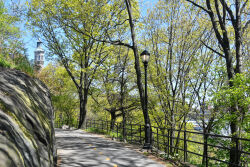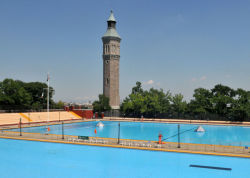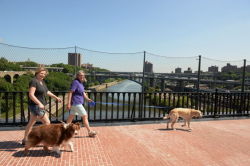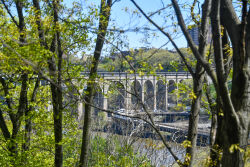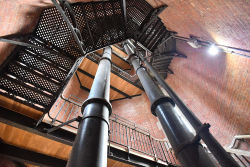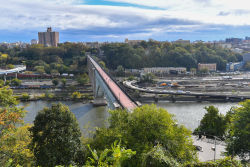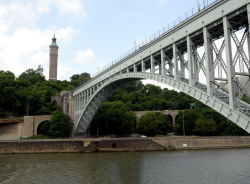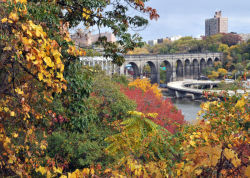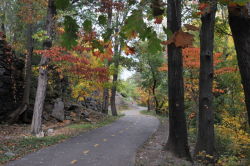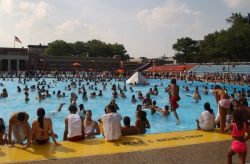Highbridge Park
The Daily Plant : Tuesday, November 28, 2006
Plans Afoot To Reopen The City’s Oldest Bridge
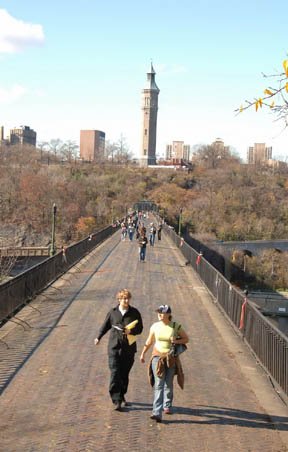
Photo by Malcolm Pinckney
On November 17, Parks & Recreation Commissioner Adrian Benepe joined Department of Transportation (DOT) Commissioner Iris Weinshall, Department of Environmental Protection (DEP) Commissioner Emily Lloyd, elected officials and community members to announce the City’s plans to reopen the High Bridge, New York City’s oldest bridge.
DOT completed a detailed structural analysis of the High Bridge on behalf of Parks that outlines the steps necessary to restore the High Bridge and reopen it to the public as a part of the New York City Greenway System. Thanks to a $5 million allocation from Congressman José E. Serrano, Parks will now begin the long-term process of reopening the landmark to the public.
Recognized as a New York City Landmark and a National Scenic Landmark, the High Bridge was built in 1848 to carry the Old Croton Aqueduct over the Harlem River. The Old Croton Aqueduct was the first of its kind ever constructed in the United States. The innovative system used a gravity feed, bringing clean, pure drinking water 41 miles into New York City through an enclosed masonry structure crossing ridges, valleys, and rivers. The bridge was designed with a pedestrian walkway atop the Aqueduct and was not used for vehicular traffic. It soars 116 feet above the 620 foot-wide Harlem River, with a total length of 1,250 feet.
Once restored, the High Bridge and trail will become a part of the growing New York City Greenway System and New Yorkers will once again be able to “promenade” across the High Bridge. Parks will take a series of steps to stabilize and repair the Bridge. DEP contributed $100,000 toward the $2.5 million DOT report, which includes all the information that Parks Department engineers and designers will need to move forward with the repairs. The total rehabilitation of the High Bridge is estimated to cost approximately $60 million, $20 to $30 million of which will fund efforts to make it safe for pedestrian access.
Congressman Serrano’s $5 million allocation, which is being matched with $1.25 million in City funds, will allow Parks to take the first steps in carrying out the vision. Initial work will include repairs to the brick walkway and the stone arches. Additional phases will include restoring the steel and completing the repairs to the walkway. The last steps will be to bring the bridge into the modern era, by adding wheelchair ramps to provide universal access onto the bridge and installing protective fencing. DEP has also allocated $500,000 to restore the High Bridge’s two historic gatehouses.
The Parks Department has already allocated $10 million to projects that support the High Bridge. Parks is set to begin a $4.2 million project to restore the missing access between the upper level of Highbridge Park in Manhattan and the 158-year-old High Bridge. It is a critical step in re-opening the bridge to allow for recreational travel between the Bronx and Manhattan. The project is expected to begin this spring and will include rebuilding the staircase in Manhattan to allow visitors to walk directly from the bridge to the recreation center or up to Amsterdam Avenue. The project will include a ramp that will accommodate visitors in wheelchairs as well as bicyclists.
Additional projects supporting the High Bridge include the 2002 reconstruction of Highbridge Park in the Bronx, collaboration with DEP to rebuild the gatehouse roof and clean the stonework, and construction of the Manhattan Waterfront Greenway along the nearby Harlem River Speedway. In addition, Parks will utilize $2.6 million in Croton mitigation funds to extend the waterfront greenway along the Harlem River into the Bronx.
Since 2003, the High Bridge Catalyst Project, a joint project of the Parks Department and City Parks Foundation, has fostered interaction, planning and activities among over 75 community groups and organizations who have collectively expressed interest in seeing the High Bridge re-opened. From 2003 through 2007, City Parks Foundation will invest $1 million in Highbridge parks through Partnerships for Parks, a joint program with the Parks Department. In addition, the New York Restoration Project has worked for more than 10 years to restore and maintain Highbridge Park in Manhattan, Sherman Creek and Swindlers Cover, as well as waterway parks along the Bronx side of the Harlem River.
QUOTATION FOR THE DAY
“The hardest thing in life is to know which bridge to cross and which to burn.”
David Russell
(1942 - )
Check out your park's Vital Signs
Clean & Safe
Green & Resilient
Empowered & Engaged Users
Share your feedback or learn more about how this park is part of a
Vital Park System

